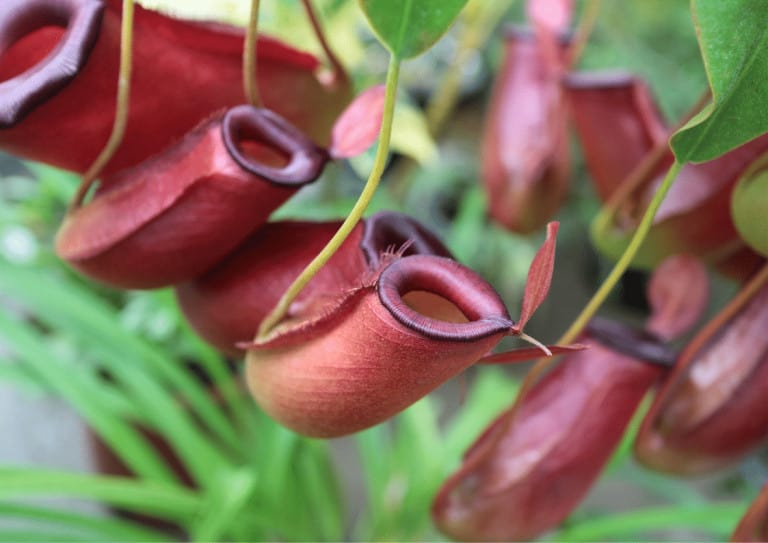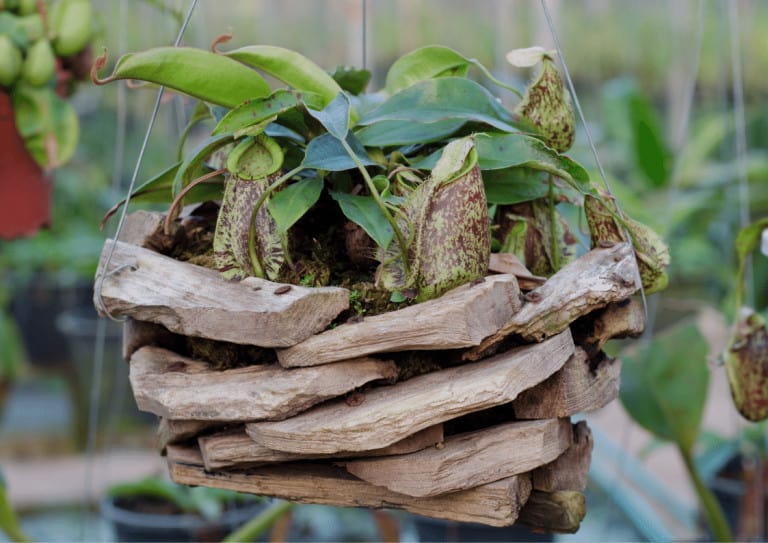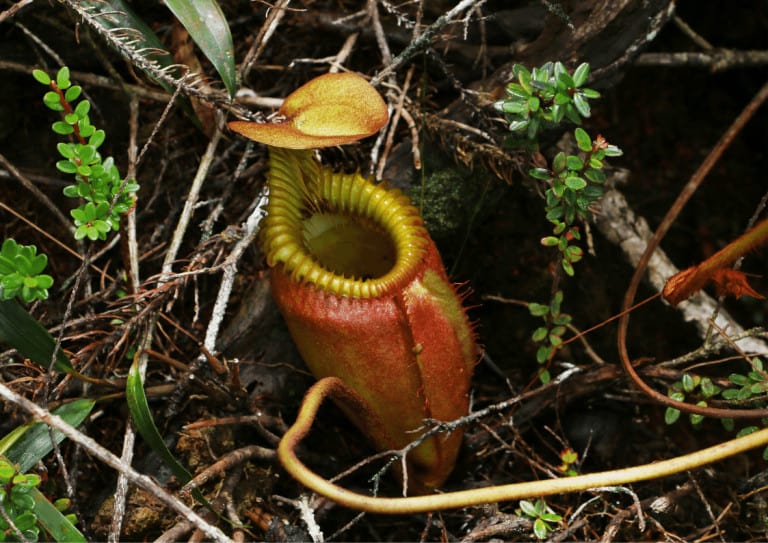Do Nepenthes Need Dormancy To Survive?
- Lakeisha Ethans
- May 8, 2022
If you buy something using the retail links in our articles, sometimes we earn a small affiliate commission. This does not impact the products we recommend.
The Nepenthes genus is made up of tropical carnivorous plants that are often called monkey cups or pitcher plants. Almost all 170 species in the genus live in temperate locations, where winter doesn’t occur and warm to hot days with cool nights are commonplace. These plants thrive in the heat!
But some Nepenthes species are moved out of their home environments for use in greenhouses or even to be sold as exotic houseplants. In these cases, the shift in their environment means they’re likely to be exposed to climates that they’re not used to, including cold to freezing temperatures when winter comes around. So do they become dormant during that season?
Dormancy is a common feature of many plants that live in climates where winter is an occurring season. In winter and colder months, it can be difficult for plants to get the nutrients, sunlight, and humidity that they need for survival. To stay alive, they enter a “dormant” phase where they are “asleep” for the season until temperatures rise sufficiently.
Nepenthes plants do not experience a dormancy phase in their natural growth cycle. They are often wrongfully assumed to become dormant due to changes in their growth and activity speeds when exposed to cold environments however in reality, their active growth continues throughout the year, regardless of the season.
No amount of cold in your climate will induce dormancy on your Nepenthes plant – but what does that mean for its care needs? Will a plant of this species and origin survive a cold winter environment without the ability to become dormant?
This article aims to shed some light on the subject by answering the following questions:
- Why don’t Nepenthes experience dormancy?
- How can you care for Nepenthes during the winter?
- Do highland Nepenthes species experience slow-growing dormancy due to cold environments?
- Why do Nepenthes pitchers die off during the winter months?

Why don’t Nepenthes experience dormancy?
Dormancy in plants is almost akin to hibernation. It’s best defined as a period of decreased metabolic activity. During this period, a plant is capable of being entirely “asleep”, not requiring light, and having reduced care needs. They then only re-awaken when the temperature rises again. Why doesn’t this happen in Nepenthes?
Nepenthes are tropical plants. They rarely grow in environments where winter occurs. As such, they don’t naturally have a built-in response to cold climates. Their response to climate shifts involves slowing down growth but remaining active instead of becoming completely dormant.
This is also partially the reason that not all Nepenthes species are suitable for private cultivation outside of their natural habitats, though many additional factors affect this reality.
How can you care for Nepenthes during the winter?
You now know that a Nepenthes plant has no reason to know how to enter dormancy or to need it. But a houseplant Nepenthes might be living in a country or environment that does experience winter. In that case, it will need special care to survive a climate it’s not prepared for. Luckily, this isn’t too complex!
The first thing to do is to try and get more light to your Nepenthes. You can move it to a location with more light as the colder seasons come breezing in. Or you can simply opt for artificial light. Plenty of simple grow lights will be able to provide your Nepenthes with enough light to do well throughout the winter.
Some people find that turning these artificial lights on at night is beneficial for your Nepenthes. Others leave it on throughout the day. You’ll have to consider your unique species’ needs before deciding on this.
Next, work on increasing humidity. Winter can often be quite a dry season, which can be fairly bad for Nepenthes plants. A humidifier suited to houseplants is a great way to quickly boost the humidity levels in your house, but there are other ways to achieve this. For example, you can use a spray bottle to gently mist your Nepenthes’ main stem and leaves to boost its humidity.
Another way to achieve better humidity is by filling a tray with rocks, adding a little bit of distilled water, and then placing the potted Nepenthes onto the rocks. Do note that the plant should not be sitting inside the water, merely existing above it for the moisture. You may also want to move the Nepenthes to a more humid room in your home, like the bathroom or kitchen.

Do highland Nepenthes species experience slow-growing dormancy due to cold environments?
Some species of Nepenthes live at high altitudes, away from the usual tropical climates of their “siblings”. But do these species experience dormancy due to their colder environments, and if so, do they need special care considerations?
The answer is no! Even high-altitude, highland Nepenthes do not experience technical dormancy, as they still live in tropical nations without winter. What’s more important to these plants is the deep temperature drop that happens each night.
One commonly loved highland Nepenthes is the Nepenthes rajah, so we’ll use it as an example here. These plants naturally grow only in Malaysia, which is a hot, tropical country without four seasons. They live in a mountainous area where temperatures drop to near-freezing levels each night.
Most other highlander Nepenthes plants live in similar conditions. They need a drop in temperature of 10 degrees Celsius or more each night to signal the end of the day. This is used to tell the passing of days in the same way that most plants use the sun as a signal of time passing.
As such, when kept as a houseplant or grown in a greenhouse, a Nepenthes needs to have temperature drops at night that mimic this. Without the proper dropping in temperature, they will either live a shortened life or be unable to grow sufficiently. In other words, it’s not dormancy that the plants are experiencing, but a natural, normal part of their everyday cycles.
Why do Nepenthes pitchers die off during winter months?
It can be concerning to see your Nepenthes pitchers die when it gets cold where you live. It might make you worry that these plants genuinely need an induced state of dormancy. You might even assume that this “death” is a form of dormancy. In reality, this isn’t anything that you need to worry about, and it’s natural and harmless.
Old Nepenthes pitchers die during the winter months as they finish their life cycles. This is because growth slows down in cold times, which reduces the plant’s “interest” in supporting pitchers that are already quite aged. The focus will instead turn to support new pitcher growth, which is slowed due to the climate.

Take home message
Nepenthes plants don’t experience or need a dormancy stage. They come from tropical climates and prioritize using temperature as an indication of a daily cycle as opposed to a need for dormancy. In fact, even highlander Nepenthes that regularly face freezing temperatures don’t enter dormancy at all.
When exposed to cold environments, a Nepenthes’ growth may slow down and old pitchers may die, but the plants continue their active growth. It’s a common misconception that they enter dormancy, likely because their growth slows down and can mimic typical dormancy. However, they maintain their usual metabolic needs throughout this time.
You can give a Nepenthes proper care during the winter months by ensuring sufficient humidity and light exposure. Due to the large variety of Nepenthes species out there, you’ll have to read up on your unique individual plant’s needs to determine how to give it necessary care. Lowland Nepenthes will likely need more care than their highland counterparts.

Lakeisha Ethans
Houseplant Writer
Mother to two humans and hundreds of plant babies. Lakeisha uses her 15 years of experience as a content writer to specialise in simplifying what you need to know to grow and care for all indoor plants.
Similar Posts
41 Snake Plant Names So Funny, You’ll Struggle To Pick One
Why not give each plant in your houseplant collection their own unique name. Here are a list of funny names that you could give to your Snake plant.
9 Stunning Succulent Selling Etsy Shops | 2023 Reviews
Shopping for succulents on Etsy offers more choice, better prices and access to knowledgeable and passionate sellers. Here's our favorite succulent shops.



